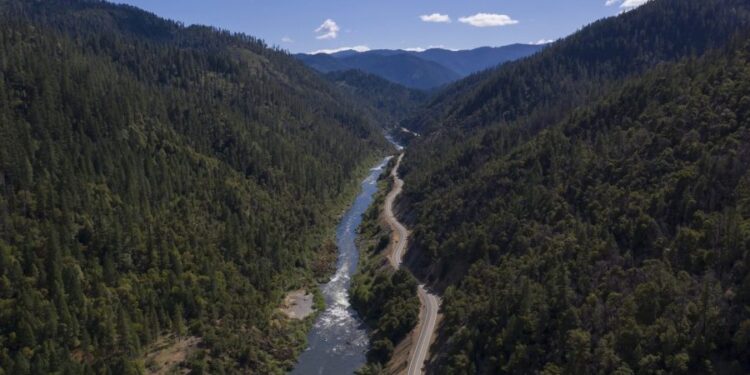
California Gov. Gavin Newsom (D) on Wednesday announced the completion of final efforts to remove the state’s massive and controversial Klamath dams.
The elimination of these barricades — the largest such infrastructural undertaking in American history — will now pave the way for a Klamath River restoration project, according to the governor’s office. That work will involve reviving some 2,200 acres of formerly submerged lands, while enabling fish populations to swim freely.
“This is a monumental achievement — not just for the Klamath River but for our entire state, nation, and planet,” Newsom said in a statement. “By taking down these outdated dams, we are giving salmon and other species a chance to thrive once again, while also restoring an essential lifeline for tribal communities who have long depended on the health of the river.”
For decades, members of area tribes have fought for the removal of these structures, which sat on the ancestral lands of the Yurok, Karuk and Klamath communities near the California-Oregon border.
The four hydroelectric dams, whose construction began in 1918, ended up obstructing river flow, reducing water quality, raising water temperatures and making the life cycles of salmon and steelhead populations all but impossible, the governor’s office stated.
The dams blocked these fish, which are critical to the tribes, from reaching more than 300 miles of spawning and rearing areas within the river’s upper basin, according to California Trout. Today, less than 3 percent of the original spring-run Chinook salmon population remains, per the group.
“Our áama, ancestral companions, can now return to over 400 miles of unleashed spawning grounds, renewing a bond that has nourished our people since time immemorial,” Russell Attebery, chairman of the Karuk Tribe, said in a statement.
“The river is cleansing itself, and with time, its waters will grow purer,” Attebery continued. “The scars left by the dams will fade and balance will be restored to the land. This is a reclamation of our cultural heritage, traditional knowledge, and sovereign rights.”
The Klamath River Renewal Corporation, a nonprofit that has been overseeing the removal process, confirmed on Wednesday that the elimination of all diversion infrastructure, temporary bridges and dam materials was complete.
“Restoration and recovery of the river will continue for the coming years,” a press release from the organization said.
Throughout the fall, restoration crews will be working on amending soil conditions in previously submerged areas and then conduct seeding and planting efforts, according to the corporation.
Following the final removal of heavy equipment on Wednesday, officials from the National Oceanic and Atmospheric Administration’s (NOAA) Fisheries branch acknowledged that the reconnected river was turbid — opaque or containing stirred-up sediment — but stressed that it was safe for fish.
“These final dam removal steps set the stage for salmon to return to reclaimed habitat and expand their population recovery,” Jim Simondet, NOAA Fisheries West Coast Region Klamath branch supervisor, said in a statement.
NOAA Fisheries experts noted that they had previously analyzed the impacts of the dam removal on the area’s Endangered Species Act-listed fish in an official biological opinion. Their findings showed that the long-term benefits of large-scale ecosystem restoration would far outweigh the potential short-term impacts of sediment presence on salmon.
To minimize harm and maximize water quality, NOAA Fisheries teams said they coordinated with tribal, state and other federal experts. Throughout this process, crews released sediment in a way that muddied the river but prevented a decline in oxygen, according to the agency.
Joseph James, chairman of the Yurok tribe, characterized the “tribally led effort to dismantle the dams” as “an expression of our sacred duty to maintain balance in the world.”
“That is why we fought so hard for so long to tear down the dams and bring the salmon home,” James added.







